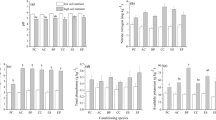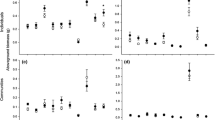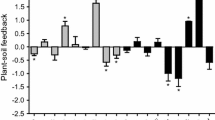Abstract
Background and aims
Soil heterogeneity can be caused by plant-soil feedback (PSF), but little is known about how this affects plant growth and the distribution of roots. Moreover, as invasive and native plant species frequently differ in PSF and root-foraging ability, they may differ in their responses to PSF-mediated soil heterogeneity.
Methods
We first conditioned soils by 16 plant species (eight confamilial pairs of invasive alien and native species). Then, we grew each species in a homogeneous treatment with unconditioned soil and in three heterogeneous treatments with four patches. In the home-soil treatment, we filled two patches with unconditioned soil and two with soil conditioned by the target species. In the foreign-soil treatment, we filled two patches with unconditioned soil and two with soil conditioned by the other species in a pair. In the home-and-foreign-soil treatment, we filled two patches with home soil and two with foreign soil.
Results
Compared to the homogeneous unconditioned soil treatment, PSF negatively affected plant growth. In the heterogeneous treatment with control- and home-soil patches, biomass was reduced more strongly for the invasive species than for the native species. In the heterogeneous treatment with both home- and foreign-soil patches, root biomass of the invasive species was greater in the foreign-soil than in the home-soil patches, whereas the reverse was true for natives.
Conclusion
Although invasive species suffered more from conspecific PSF, root foraging allowed them to avoid home soil. In the long term, this could help invasive species gain a competitive advantage over natives.



Similar content being viewed by others
Data availability
The raw data are available upon request to the corresponding author.
References
Aldorfová A, Knobová P, Münzbergová Z (2020) Plant-soil feedback contributes to predicting plant invasiveness of 68 alien plant species differing in invasive status. Oikos 129:1257–1270
Bennett JA, Klironomos J (2019) Mechanisms of plant-soil feedback: interactions among biotic and abiotic drivers. New Phytol 222:91–96
Bennett JA, Maherali H, Reinhart KO, Lekberg Y, Hart MM, Klironomos J (2017) Plant-soil feedbacks and mycorrhizal type influence temperate forest population dynamics. Science 355:181–184
Bever JD, Westover KM, Antonovics J (1997) Incorporating the soil community into plant population dynamics: the utility of the feedback approach. J Ecol 85:561–573
Bezemer TM, Jing J, Bakx-Schotman JMT, Bijleveld E-J (2018) Plant competition alters the temporal dynamics of plant-soil feedbacks. J Ecol 106:2287–2300
Birch CPD, Hutchings MJ (1994) Exploitation of patchily distributed soil resources by the clonal herb Glechoma hederacea. J Ecol 82:653–664
Brandt AJ, de Kroon H, Reynolds HL, Burns JH (2013) Soil heterogeneity generated by plant-soil feedbacks has implications for species recruitment and coexistence. J Ecol 101:277–286
Broadbent A, Stevens CJ, Peltzer DA, Ostle NJ, Orwin KH (2018a) Belowground competition drives invasive plant impact on native species regardless of nitrogen availability. Oecologia 186:577–587
Broadbent AADAD, Stevens CJ, Ostle NJ, Orwin KH (2018b) Biogeographic differences in soil biota promote invasive grass response to nutrient addition relative to co-occurring species despite lack of belowground enemy release. Oecologia 186:611–620
Bunn RA, Ramsey PW, Lekberg Y (2015) Do native and invasive plants differ in their interactions with arbuscular mycorrhizal fungi? A meta-analysis. J Ecol 103:1547–1556
Callaway RM, Ridenour WM (2004) Novel weapons: invasive success and the evolution of increased competitive ability. Front Ecol Environ 2:436–443
Callaway RM, Thelen GC, Rodriguez A, Holben WE (2004) Soil biota and exotic plant invasion. Nature 427:731–733
Chen D, Ali A, Yong XH, Lin CG, Niu XH, Cai AM, Dong BC, Zhou ZX, Wang YJ, Yu FH (2019) A multi-species comparison of selective placement patterns of ramets in invasive alien and native clonal plants to light, soil nutrient and water heterogeneity. Sci Total Environ 657:1568–1577
Coley PD, Bryant JP, Chapin FS (1985) Resource availability and plant antiherbivore defense. Science 230:895–899
Dawson W (2015) Release from belowground enemies and shifts in root traits as interrelated drivers of alien plant invasion success: a hypothesis. Ecol Evol 5:4505–4516
Dawson W, Fischer M, van Kleunen M (2011) The maximum relative growth rate of common UK plant species is positively associated with their global invasiveness. Glob Ecol Biogeogr 20:299–306
Dawson W, Moser D, van Kleunen M, Kreft H, Pergl J, Pysek P, Weigelt P, Winter M, Lenzner B, Blackburn TM, Dyer EE, Cassey P, Scrivens SL, Economo EP, Guenard B, Capinha C, Seebens H, Garcia-Diaz P, Nentwig W, Garcia-Berthou E et al (2017) Global hotspots and correlates of alien species richness across taxonomic groups. Nat Ecol Evol 1:0186
Dawson W, Schrama M (2016) Identifying the role of soil microbes in plant invasions. J Ecol 104:1211–1218
Diez JM, Dickie I, Edwards G, Hulme PE, Sullivan JJ, Duncan RP (2010) Negative soil feedbacks accumulate over time for non-native plant species. Ecol Lett 13:803–809
Dong BC, Wang JZ, Liu RH, Zhang MX, Luo FL, Yu FH (2015) Soil heterogeneity affects ramet placement of Hydrocotyle vulgaris. J Plant Ecol 8:91–100
Dostál P, Müllerová J, Pyšek P, Pergl J, Klinerová T (2013) The impact of an invasive plant changes over time. Ecol Lett 16:1277–1284
Dostálek T, Münzbergová Z, Kladivová A, Macel M (2016) Plant-soil feedback in native vs invasive populations of a range expanding plant. Plant Soil 399:209–220
Enders M, Havemann F, Ruland F, Bernard-Verdier M, Catford JA, Gómez-Aparicio L, Haider S, Heger T, Kueffer C, Kühn I, Meyerson LA, Musseau C, Novoa A, Ricciardi A, Sagouis A, Schittko C, Strayer DL, Vila M, Essl F, Hulme PE et al (2020) A conceptual map of invasion biology: integrating hypotheses into a consensus network. Glob Ecol Biogeogr 29:978–991
Fagan WF, Lewis MA, Neubert MG, Van Den Driessche P (2002) Invasion theory and biological control. Ecol Lett 5:148–157
Fitter A (1982) Influence of soil heterogeneity on the coexistence of grassland species. J Ecol 70:139–148
Florianová A, Hanzelková V, Drtinová L, Pánková H, Cajthaml Y, Münzbergová Z (2023) Plant-soil interactions in the native range of two congeneric species with contrasting invasive success. Oecologia 201:461–477
Flory SL, Long F, Clay K (2011) Invasive Microstegium populations consistently outperform native range populations across diverse environments. Ecology 92:2248–2257
Grotkopp E, Rejmánek M (2007) High seedling relative growth rate and specific leaf area are traits of invasive species: phylogenetically independent contrasts of woody angiosperms. Am J Bot 94:526–532
Hendriks M, Mommer L, de Caluwe H, Smit-Tiekstra AE, van der Putten WH, de Kroon H (2013) Independent variations of plant and soil mixtures reveal soil feedback effects on plant community overyielding. J Ecol 101:287–297
Hendriks M, Ravenek JM, Smit-Tiekstra AE, van der Paauw JW, de Caluwe H, van der Putten WH, de Kroon H, Mommer L (2015a) Spatial heterogeneity of plant-soil feedback affects root interactions and interspecific competition. New Phytol 207:830–840
Hendriks M, Visser EJW, Visschers IGS, Aarts BHJ, de Caluwe H, Smit-Tiekstra AE, van der Putten WH, de Kroon H, Mommer L (2015b) Root responses of grassland species to spatial heterogeneity of plant-soil feedback. Funct Ecol 29:177–186
Hierro JL, Maron JL, Callaway RM (2005) A biogeographical approach to plant invasions: the importance of studying exotics in their introduced and native range. J Ecol 93:5–15
Hulme PE (2017) Climate change and biological invasions: evidence, expectations, and response options. Biol Rev 92:1297–1313
in’t Zandt D, van den Brink A, de Kroon H, Visser EJ (2019) Plant-soil feedback is shut down when nutrients come to town. Plant Soil 439:541–551
Jiang J, Abbott KC, Baudena M, Eppinga MB, Umbanhowar JA, Bever JD (2020) Pathogens and mutualists as joint drivers of host species coexistence and turnover: implications for plant competition and succession. Am Nat 195:591–602
Joshi J, Vrieling K (2005) The enemy release and EICA hypothesis revisited: incorporating the fundamental difference between specialist and generalist herbivores. Ecol Lett 8:704–714
Kardol P, Martijn Bezemer T, Van Der Putten WH (2006) Temporal variation in plant–soil feedback controls succession. Ecol Lett 9:1080–1088
Keane RM, Crawley MJ (2002) Exotic plant invasions and the enemy release hypothesis. Trends Ecol Evol 17:164–170
Kempel A, Rindisbacher A, Fischer M, Allan E (2018) Plant soil feedback strength in relation to large-scale plant rarity and phylogenetic relatedness. Ecology 99:597–606
Kempel A, Schädler M, Chrobock T, Fischer M, van Kleunen M (2011) Tradeoffs associated with constitutive and induced plant resistance against herbivory. Proc Natl Acad Sci 108:5685–5689
Keser LH, Dawson W, Song YB, Yu FH, Fischer M, Dong M, van Kleunen M (2014) Invasive clonal plant species have a greater root-foraging plasticity than non-invasive ones. Oecologia 174:1055–1064
Keser LH, Visser EJW, Dawson W, Song YB, Yu FH, Fischer M, Dong M, van Kleunen M (2015) Herbaceous plant species invading natural areas tend to have stronger adaptive root foraging than other naturalized species. Front Plant Sci 6:273
Klironomos JN (2002) Feedback with soil biota contributes to plant rarity and invasiveness in communities. Nature 417:67–70
Kulmatiski A, Beard KH, Stevens JR, Cobbold SM (2008) Plant-soil feedbacks: a meta-analytical review. Ecol Lett 11:980–992
Lemmermeyer S, Lörcher L, van Kleunen M, Dawson W (2015) Testing the plant growth-defense hypothesis belowground: do faster-growing herbaceous plant species suffer more negative effects from soil biota than slower-growing ones? Am Nat 186:264–271
Mangla S, Callaway RM (2008) Exotic invasive plant accumulates native soil pathogens which inhibit native plants. J Ecol 96:58–67
Maron JL, Klironomos J, Waller L, Callaway RM (2014) Invasive plants escape from suppressive soil biota at regional scales. J Ecol 102:19–27
McCarthy-Neumann S, Kobe RK (2010) Conspecific plant-soil feedbacks reduce survivorship and growth of tropical tree seedlings. J Ecol 98:396–407
Peng YK, Luo FL, Li HL, Yu FH (2013) Growth responses of a rhizomatous herb Bolboschoenus planiculmis to scale and contrast of soil nutrient heterogeneity chinese. J Plant Ecol 37:335
Pinheiro J, Bates D, DebRoy S, Sarkar D, R Core Team (2015) nlme: linear and nonlinear mixed effects models. https://CRANR-project.org/package=nlme. Accessed 19 Aug 2015
R Core Team (2019) R: a language and environment for statistical computing. R Foundation for Statistical Computing, Vienna, Austria. http://www.R-project.org. Accessed 12 Dec 2019
Reinhart KO, Packer A, van der Putten WH, Clay K (2003) Plant-soil biota interactions and spatial distribution of black cherry in its native and invasive ranges. Ecol Lett 6:1046–1050
Richardson DM, Pyšek P, Rejmánek M, Barbour MG, Panetta FD, West CJ (2000) Naturalization and invasion of alien plants: concepts and definitions. Divers Distrib 6:93–107
Saul W-C, Jeschke J, Heger T (2013) The role of eco-evolutionary experience in invasion success. NeoBiota 17:57–74
Seebens H, Blackburn TM, Dyer EE, Genovesi P, Hulme PE, Jeschke JM, Pagad S, Pysek P, Winter M, Arianoutsou M, Bacher S, Blasius B, Brundu G, Capinha C, Celesti-Grapow L, Dawson W, Dullinger S, Fuentes N, Jager H, Kartesz J et al (2017) No saturation in the accumulation of alien species worldwide. Nat Commun 8:14435
Semchenko M, Saar S, Lepik A (2017) Intraspecific genetic diversity modulates plant–soil feedback and nutrient cycling. New Phytol 216:90–98
Shea K, Chesson P (2002) Community ecology theory as a framework for biological invasions. Trends Ecol Evol 17:170–176
Smith LM, Reynolds HL (2015) Plant-soil feedbacks shift from negative to positive with decreasing light in forest understory species. Ecology 96:2523–2532
Song YB, Yu FH, Keser LH, Dawson W, Fischer M, Dong M, van Kleunen M (2013) United we stand, divided we fall: a meta-analysis of experiments on clonal integration and its relationship to invasiveness. Oecologia 171:317–327
Teste FP, Kardol P, Turner BL, Wardle DA, Zemunik G, Renton M, Laliberte E (2017) Plant-soil feedback and the maintenance of diversity in Mediterranean-climate shrublands. Science 355:173–176
Van der Putten WH (2002) How to be invasive. Nature 417:32–33
van der Putten WH, Bardgett RD, Bever JD, Bezemer TM, Casper BB, Fukami T, Kardol P, Klironomos JN, Kulmatiski A, Schweitzer JA, Suding KN, Van de Voorde TFJ, Wardle DA (2013) Plant-soil feedbacks: the past, the present and future challenges. J Ecol 101:265–276
Verhoeven KJF, Biere A, Harvey JA, van der Putten WH (2009) Plant invaders and their novel natural enemies: who is naive? Ecol Lett 12:107–117
Vilà M, Espinar JL, Hejda M, Hulme PE, Jarošík V, Maron JL, Pergl J, Schaffner U, Sun Y, Pyšek P (2011) Ecological impacts of invasive alien plants: a meta-analysis of their effects on species, communities and ecosystems. Ecol Lett 14:702–708
Vivanco JM, Bais HP, Stermitz FR, Thelen GC, Callaway RM (2004) Biogeographical variation in community response to root allelochemistry: novel weapons and exotic invasion. Ecol Lett 7:285–292
Wandrag EM, Bates SE, Barrett LG, Catford JA, Thrall PH, van der Putten WH, Duncan RP (2020) Phylogenetic signals and predictability in plant–soil feedbacks. New Phytol 228:1440–1449
Wang YJ, Chen D, Yan R, Yu FH, van Kleunen M (2019) Invasive alien clonal plants are competitively superior over co-occurring native clonal plants. Perspect Plant Ecol Evol Syst 40:125484
Wang YJ, Liu YY, Chen D, Du DL, Müller-Schärer H, Yu FH (2022) Clonal functional traits favor the invasive success of alien plants into native communities. Ecol Appl. https://doi.org/10.1002/eap.2756
Wang YJ, Müller-Schärer H, van Kleunen M, Cai AM, Zhang P, Yan R, Dong BC, Yu FH (2017) Invasive alien plants benefit more from clonal integration in heterogeneous environments than natives. New Phytol 216:1072–1078
Wolfe BE, Klironomos JN (2005) Breaking new ground: soil communities and exotic plant invasion. Bioscience 55:477–487
Wubs ERJ, Bezemer TM (2016) Effects of spatial plant-soil feedback heterogeneity on plant performance in monocultures. J Ecol 104:364–376
Xue W, Berendse F, Bezemer TM (2018) Spatial heterogeneity in plant-soil feedbacks alters competitive interactions between two grassland plant species. Funct Ecol 32:2085–2094
Yuan L, Li J-M, Yu F-H, Oduor AMO, van Kleunen M (2021) Allelopathic and competitive interactions between native and alien plants. Biol Invasions 23:3077–3090
Zhang Z, Liu Y, Brunel C, van Kleunen M (2020) Soil-microorganism-mediated invasional meltdown in plants. Nat Ecol Evol 4:1612–1621
Zhang Z, Liu Y, Yuan L, Weber E, van Kleunen M (2021) Effect of allelopathy on plant performance: a meta-analysis. Ecol Lett 24:348–362
Zhao Y, Zhao CY, Liu YY, Yan Z, Wang YJ (2023) Clonal integration facilitates higher resistance to potentially toxic element stress in invasive alien plants than in natives. Plant Soil. https://doi.org/10.21203/rs.3.rs-3035537/v1
Zheng YL, Feng YL, Zhang LK, Callaway RM, Valiente-Banuet A, Luo DQ, Liao ZY, Lei YB, Barclay GF, Silva-Pereyra C (2015) Integrating novel chemical weapons and evolutionarily increased competitive ability in success of a tropical invader. New Phytol 205:1350–1359
Zhong W, Gu T, Wang W, Zhang B, Lin X, Huang Q, Shen W (2010) The effects of mineral fertilizer and organic manure on soil microbial community and diversity. Plant Soil 326:511–522
Zuur AF, Ieno EN, Walker N, Saveliev AA, Smith GM (2009) Mixed effects models and extensions in ecology with R. Springer, New York, NY
Acknowledgements
We thank Aiming Cai, Changgen Lin, Rong Yan, Lie Xu, Xin He, Hongfei Shu and Xiaoxu Yin for the practical assistance. This research was supported by the National Natural Science Foundation of China (32171510, 31770449, 32071527), by the Fundamental Research Funds for the Central Universities (2662020YLPY016) and by the Ten Thousand Talents Program of Zhejiang Province (2018R52016).
Author information
Authors and Affiliations
Contributions
D.C. and Y.J.W. designed the experiment. D.C. performed the experiment. D.C. and Y.J.W. carry out the statistical analysis. D.C. wrote the first draft of the manuscript. F.H.Y and M.v.K. contributed substantially to the revisions.
Corresponding authors
Ethics declarations
Conflict of interest
The authors declare that they have no conflict of interest.
Additional information
Responsible Editor: Luca Bragazza.
Publisher’s Note
Springer Nature remains neutral with regard to jurisdictional claims in published maps and institutional affiliations.
Supplementary information
Below is the link to the electronic supplementary material.
ESM 1
(PDF 564 KB)
Rights and permissions
Springer Nature or its licensor (e.g. a society or other partner) holds exclusive rights to this article under a publishing agreement with the author(s) or other rightsholder(s); author self-archiving of the accepted manuscript version of this article is solely governed by the terms of such publishing agreement and applicable law.
About this article
Cite this article
Chen, D., van Kleunen, M., Wang, YJ. et al. Invasive and native plants show different root responses to feedback-mediated soil heterogeneity. Plant Soil 494, 497–508 (2024). https://doi.org/10.1007/s11104-023-06296-w
Received:
Accepted:
Published:
Issue Date:
DOI: https://doi.org/10.1007/s11104-023-06296-w




